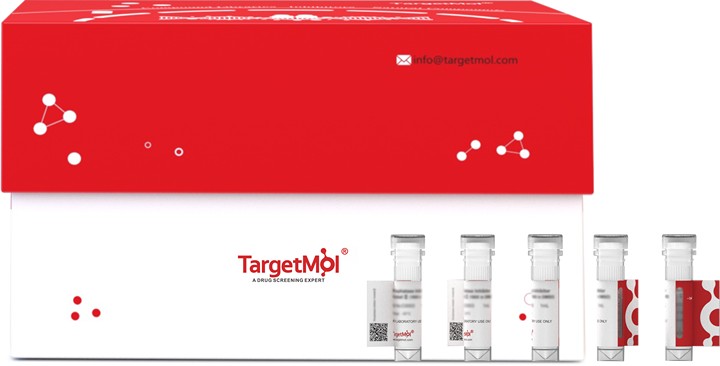Shopping Cart
- Remove All
 Your shopping cart is currently empty
Your shopping cart is currently empty

BoNT/D Protein, Clostridium botulinum, Recombinant (B2M & His) is expressed in E. coli expression system with N-6xHis-B2M tag. The predicted molecular weight is 64.5 kDa and the accession number is P19321.

| Pack Size | Price | Availability | Quantity |
|---|---|---|---|
| 20 μg | $360 | 20 days | |
| 100 μg | $745 | 20 days | |
| 1 mg | $2,530 | 20 days |
| Biological Activity | Activity has not been tested. It is theoretically active, but we cannot guarantee it. If you require protein activity, we recommend choosing the eukaryotic expression version first. |
| Description | BoNT/D Protein, Clostridium botulinum, Recombinant (B2M & His) is expressed in E. coli expression system with N-6xHis-B2M tag. The predicted molecular weight is 64.5 kDa and the accession number is P19321. |
| Species | Clostridium botulinum |
| Expression System | E. coli |
| Tag | N-6xHis-B2M |
| Accession Number | P19321 |
| Synonyms | Botulinum neurotoxin type D,botD,Bontoxilysin-D,BoNT/D |
| Amino Acid | MTWPVKDFNYSDPVNDNDILYLRIPQNKLITTPVKAFMITQNIWVIPERFSSDTNPSLSKPPRPTSKYQSYYDPSYLSTDEQKDTFLKGIIKLFKRINERDIGKKLINYLVVGSPFMGDSSTPEDTFDFTRHTTNIAVEKFENGSWKVTNIITPSVLIFGPLPNILDYTASLTLQGQQSNPSFEGFGTLSILKVAPEFLLTFSDVTSNQSSAVLGKSIFCMDPVIALMHELTHSLHQLYGINIPSDKRIRPQVSEGFFSQDGPNVQFEELYTFGGLDVEIIPQIERSQLREKALGHYKDIAKRLNNINKTIPSSWISNIDKYKKIFSEKYNFDKDNTGNFVVNIDKFNSLYSDLTNVMSEVVYSSQYNVKNRTHYFSRHYLPVFANILDDNIYTIRDGFNLTNKGFNIENSGQNIERNPALQKLSSESVVDLFTKVCLRLTK |
| Construction | 1-442 aa |
| Protein Purity | > 85% as determined by SDS-PAGE. |
| Molecular Weight | 64.5 kDa (predicted) |
| Endotoxin | < 1.0 EU/μg of the protein as determined by the LAL method. |
| Formulation | Tris-based buffer, 50% glycerol |
| Reconstitution | A Certificate of Analysis (CoA) containing reconstitution instructions is included with the products. Please refer to the CoA for detailed information. |
| Stability & Storage | Lyophilized powders can be stably stored for over 12 months, while liquid products can be stored for 6-12 months at -80°C. For reconstituted protein solutions, the solution can be stored at -20°C to -80°C for at least 3 months. Please avoid multiple freeze-thaw cycles and store products in aliquots. |
| Shipping | In general, Lyophilized powders are shipping with blue ice. Solutions are shipping with dry ice. |
| Research Background | Botulinum toxin causes flaccid paralysis by inhibiting neurotransmitter (acetylcholine) release from the presynaptic membranes of nerve terminals of the eukaryotic host skeletal and autonomic nervous system, with frequent heart or respiratory failure. Precursor of botulinum neurotoxin D for which a proteinaceous coreceptor is controversial. In double SV2A/SV2B knockout mice this toxin does not degrade its synaptobrevin target; introducing SV2A, SV2B or SV2C restores target cleavage. Recognition of SV2 by this toxin does not occur via SV2 glycosylation or its large extracellular loop 4. Another group does not find a convincing interaction with SV2. Thus a protein receptor for this BoNT serotype has yet to be definitively proven. Recognizes at least 1 complex polysialylated ganglioside found on neural tissue. Electrical stimulation increases uptake of toxin in an ex vivo assay, presumably by transiently exposing a receptor usually found in eukaryotic target synaptic vesicles. Upon synaptic vesicle recycling the toxin is taken up via the endocytic pathway; when the pH of the toxin-containing endosome drops a structural rearrangement occurs so that the N-terminus of the heavy chain (HC) forms pores that allows the light chain (LC) to translocate into the cytosol. Once in the cytosol the disulfide bond linking the 2 subunits is reduced and LC cleaves its target protein on synaptic vesicles, preventing their fusion with the cytoplasmic membrane and thus neurotransmitter release. Requires complex eukaryotic host polysialogangliosides for full neurotoxicity and for binding to neurons.; Has proteolytic activity. After translocation into the eukaryotic host cytosol, inhibits neurotransmitter release by acting as a zinc endopeptidase that cleaves the '61-Lys-|-Leu-62' bond of synaptobrevin-1 (VAMP1), and the equivalent 'Lys-|-Leu' sites in VAMP2 and VAMP3. Cleaves the '49-Lys-|-Ile-50' bond of A.californica synaptobrevin (AC P35589). This chain probably has to be partially unfolded to translocate into the eukaryotic host cell cytosol.; Responsible for host epithelial cell transcytosis, host nerve cell targeting and translocation of light chain (LC) into eukaryotic host cell cytosol. Composed of 3 subdomains; the translocation domain (TD), and N-terminus and C-terminus of the receptor-binding domain (RBD). The RBD is responsible for the adherence of the toxin to the eukaryotic target cell surface. The N-terminus of the TD wraps an extended belt around the perimeter of the LC, protecting Zn(2+) in the active site; it may also prevent premature LC dissociation from the translocation channel and protect toxin prior to translocation. The TD inserts into synaptic vesicle membrane to allow translocation into the host cytosol. The RBD binds eukaryotic host phosphatidylethanolamine, which may serve as toxin receptor. Treatment of synaptosomes with proteinase K does not reduce HC binding, suggesting there is no protein receptor or it is protected from extracellular proteases. HC significantly decreases uptake and toxicity of whole BoNT/D. HC also interferes with uptake of tetanus toxin. Has 2 closely located carbohydrate-binding receptor sites and binds at least 1 GT1b ganglioside. Bind gangliosides in the order GD2 > GT1b > GD1b. Interacts with eukaryotic target protein SV2B (synaptic vesicle glycoprotein 2B). Expression of SV2A, SV2B or SV2C in mice knocked-out for the SV2 proteins restores entry of BoNT/D and cleavage of VAMP2, suggesting SV2 acts as its receptor. Unlike BoNT/A and BoNT/E, toxin uptake is not mediated by large extracellular loop 4 of SV2. Another group finds very poor interaction with SV2 proteins, suggesting the possible protein receptor may not have been identified. |

Copyright © 2015-2025 TargetMol Chemicals Inc. All Rights Reserved.